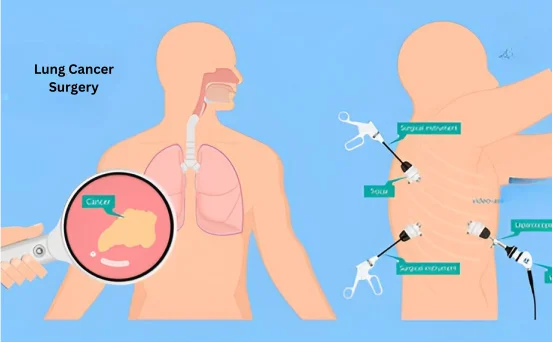Segmentectomy is a medical procedure that removes a damaged or diseased lung segment. The procedure involves the removal one or more causes for segmentectomy surgery of the bronchopulmonary system the parts of the lungs that have their own airway, artery and vein. Segmentectomy, unlike lobectomy which removes the entire lobe of lung, is a lung sparing surgery. It retains as much lung tissue as possible. It is therefore a vital option for patients who require surgical intervention but do not want to compromise their lung function.
Segmentectomy surgery is gaining popularity as a less-invasive alternative to lobectomy. This is especially true for lung cancers in the early stages. What could cause a doctor recommend this procedure? We’ll explore the main medical reasons for this decision, including the causes for segmentectomy surgery, and what patients can expect.
What is Segmentectomy Surgery
Segmentectomy refers to a procedure in which a segment of a lung lobe is removed, instead of the entire lobe. Each lobe of the human lung is divided into segments. There are five lobes three on the right, and two on left. Surgeons can save as much lung tissue as possible by removing the affected segment.
The procedure can be performed using minimally-invasive techniques, such as video-assisted robotic surgery or video-assisted assisted thoracoscopic (VATS), which can result in a faster recovery time and fewer complications after surgery.
Why Segmentectomy Surgery Is Performed: Key Causes for Segmentectomy Surgery
Early-Stage Non-Small Cell Lung Cancer:- Early-stage non-small-cell lung cancer is a common reason for segmentectomy. If the cancer has not spread beyond one segment and is contained in a small area, surgeons will recommend a segmentectomy rather than a lobectomy. This helps preserve lung function. This is important in the following situations:
- Patients aged 65 and older
- Patients with poor pulmonary reserves
- People with lung disease such as COPD or emphysema
Many studies have shown segmentectomy to be as effective as lobectomy for early stage lung cancer patients who are carefully selected.
- Metastatic Lung Tumors:- Segmentectomy can also be used for the removal of isolated metastatic lung tumors that originate from other body parts, such as breast, colon or kidneys. The surgeon can opt for a limited segmentectomy if only one segment is affected. This will preserve more lung tissue.
- Benign Pulmonary nodules:- Not all lung cancers are nodules. When benign pulmonary nodules change in size or appearance or cause symptoms such as chest pain or coughing it may be necessary to remove them surgically. Segmentectomy is an effective treatment that minimizes the impact of breathing on such conditions.
- Bronchiectasis, Chronic Infections and Other Diseases:- Localized lung damage can occur in patients with bronchiectasis, a chronic inflammation of the airways or recurrent infections such as tuberculosis and fungal infections. In the event that medical treatment fails, surgical resection may be necessary to improve quality of living and prevent further complications.
- Congenital Lung Malformations:- Sequestrations and cystic malformations are examples of abnormal lung segments that some people have. Segmentectomy may be recommended to correct these congenital conditions, which can cause frequent infections or breathing problems.
- For Diagnostic or Biopsy Purposes:- If a needle biopsy or imaging cannot provide a definitive diagnosis, a segmentectomy may be used to remove the suspicious tissue for a comprehensive pathological examination. This procedure can be used to determine the nature of the lesion, and help guide treatment.
- Pulmonary Hamartomas & Other Rare Lung Tumors:- amartomas, which are benign lung tumors, can be large and cause symptoms. Segmentectomy is often preferred to more extensive surgery in these cases due to its precision.
Benefits of Segmentectomy over Lobectomy
As a lung sparing alternative to lobectomy, segmentectomy is becoming more popular. These are some of the key benefits:
- It is important to maintain lung function in patients with compromised respiratory systems.
- Options that are minimally invasive
- Hospital stays and recovery times are shorter
- Low risk of complications when compared with more extensive lung surgery
- Early cancer treatment is effective in reducing tumors.
Considerations and Risks
- Segmentectomy is a surgical procedure that carries some risks.
- Bleeding or infection
- Lung air leakage
- Respiratory complications
- If cancer spreads more than expected, a lobectomy is needed.
These risks will be evaluated by your thoracic surgery based on the results of lung function tests, imaging, and health status.
Conclusion
Segmentectomy surgery, a lung-saving procedure that is highly targeted and precise, can be used to treat many conditions – from lung cancer in its early stages to congenital anomalies and persistent infections. Patients who are facing segmentectomy surgery must understand the reasons behind this procedure.
This procedure is a good compromise between lung function preservation and effectiveness. It can be used to remove a cancerous or benign lesion as well as an infected segment of the lung. Your doctor may have recommended segmentectomy because it has the best outcomes with the least impact to your lung health. Speak to your pulmonologist, or thoracic surgery specialist as soon as possible about your condition.























